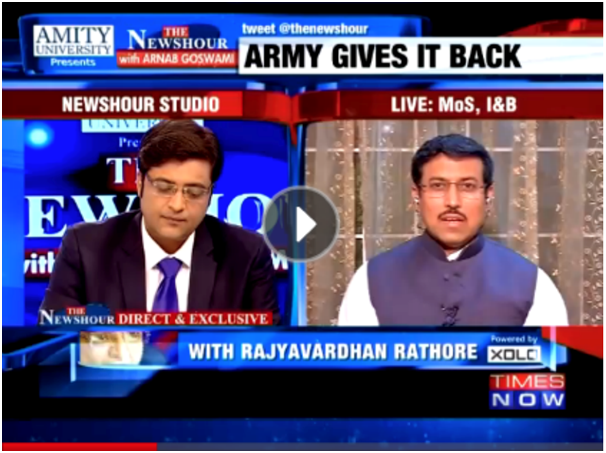NSA DOVAL OFF TO ASSUAGE ANGRY MYANMAR

NEW DELHI: India’s National Security Adviser Ajit Doval is soon headed for Myanmar, not so much to plan more raids on insurgent camps, but to assuage Naypyidaw over Delhi’s foolhardiness regarding Tuesday’s strike on rebel hideouts in the neighbouring country.
Myanmar has strongly rejected assertions that the Indian Army entered its territory in pursuit of Naga separatists.
This followed junior information minister Rajyavardhan Singh Rathore’s braggadocio on multiple television news channels on Wednesday, that Indian Army Special Forces (SF) had attacked rebel camps several kilometers inside Myanmar.
Under instructions from his political masters, the former trap shooter also underlined India’s resolve to fight terrorism beyond its frontiers via Prime Minister Narendra Modi’s robust policy of ‘hot pursuit’.
He tweeted about Modi’s 56inch chest, as if it was a bulwark against all and any terrorist attack on India.
But a statement from the presidential office in Myanmar contradicted Rathore’s assertions. It declared that fighting had erupted only on the Indian side of the border, in the contiguous provinces of Nagaland and Manipur.
Rathore’s boasting was accompanied by a similar, self-congratulatory outburst from the Ministry of Defence (MoD), which even released pictures of members of the army’s SF unit that conducted the raid on the rebel camps.
Ironically, the MoD could not even get the pictures right. It passed off those from a previous operation in 2009 as ones from the attack earlier this week. It justified its bloomer by claiming that it was a ‘representational’ snapshot.
The only sober and commendable response was from the army, following its bland statement regarding the operation on Wednesday.
Thereafter it maintained a studied silence even as Modi’s Hindu nationalist Bharatiya Janata Party (BJP) government thumped its chest over the phyrric victory.
Deniability in such clandestine matters is essential in case things go wrong.
However, it is equally vital, even if the mission goes according to plan, there are no casualties and the desired objectives are achieved.
Obfuscation in such military raids is essential to maintain the element of surprise in future and to keep the enemy guessing with regard to its modus operandi and any possible follow-up assault.
The politicians and publicity hungry MoD left little to chance sheltering, no doubt, behind Modi’s wall-to-wall chest.
Meanwhile, even Tuesday’s attack on the twin rebel camps in Myanmar is turning out to be little more than a lowlevel tactical commando raid, with questionable damage inflicted on the insurgents.
The strike employed SF- an unjustified excessive use of force under the circumstances- and strategically achieved little.
But senior army officers justify this unwarranted use of force, on the grounds that they are provided sketchy intelligence on their missions and are largely left to adopt measures to safeguard themselves, as their primary objective is zero casualties.
Under the revamped intelligence grid, overhauled after the 1999 Kargil conflict, the Indian Army continues to have a limited role in information gathering along the borders, even though it is tasked with safeguarding them.
The intelligence remit of the army covers no more than a few kilometers from India’s many borders.
Under the revamped system, the Director General of Military Intelligence (DGMI), a three-star army officer receives intelligence - albeit limited and often of little value -from various quarters.
These include the civilian Intelligence Bureau (IB), which is responsible for domestic information gathering, and its overseas counterpart, the Research and Analysis Wing (RAW).
The RAW, which is responsible for all external intelligence gathering, is the main provider of information to military and paramilitary forces of all extraordinary troop movements in the region, drawing up projections for six-month periods with a 30-day warning of impending hostilities.
The RAW's inputs are supplemented to a limited extent by local reports from the IB and the intelligence wings of the BSF and the Indo-Tibetan Border Police (ITBP)
Brigade intelligence teams and intelligence and field security units report directly to the DGMI, forwarding copies of their inputs to various army commands and forward units.
Nevertheless, it is an open secret in the army that the Military Intelligence Directorate is staffed mostly by disgruntled officers with limited prospects of promotion, who gather information of limited value and attribute their inefficiency to a shortage of resources.
One of the principal reasons advanced for its abysmal performance was the use of the directorate by army headquarters in New Delhi as its propaganda wing to 'manage' the media by garnering 'positive' reports to conceal its operational failures.
However, this time round the government is the enthusiastic propaganda force multiplier for the army. But four days later even this is beginning to appear feeble.



